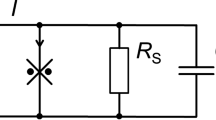Abstract
We derive expressions for the dc flux flow voltage and for the flux flow noise power spectrum in type II superconductors using a model in which flux bundles travel a distance1 less than the sample widthL before being stopped for finite times by local pinning interactions. The frequency dependence of the power spectrum is shown to be identical to our earlier derivation, where we assumed that pinning and release of flux bundles occurred in zero times, an assumption we now show to be incorrect. This frequency dependence has been shown to lead to good agreement for experimentally measured transit times, which have repeatedly been shown to be too short when obtained from models of uninter-rupted flux transit across the sample width. The concept of a pinned fraction arises naturally in our model, and occurs because of two factors; first, in certain regions the Lorentz force is not sufficient to overcome pinning, and second, in regions where flux flow occurs, fluxoids will be held up for brief periods because of interaction with local pinning centers. The expressions for the noise power at zero frequency and the dc voltage are modified by factors that depend on averages of1.
Similar content being viewed by others
References
G. J. van Gurp,Phys. Rev. 166, 436 (1968).
C. Heiden, inLow Temperature Physics—LT 13 (Plenum, New York, 1975), Vol. III, p. 75; C. Heiden and D. Kohake,Phys. Stat. Sol. (b)64, K83 (1974); C. Heiden,Solid State Commun. 18, 253 (1976).
S. W. Shen and A. van der Zeil,Physica 64, 587 (1973); H. M. Choe and A. van der Zeil,Physica 81B, 237 (1976).
P. Jarvis and J. G. Park,J. Phys. F 5, 1573 (1975).
J. D. Thompson, Ph.D. Thesis, University of Cincinnati (1975).
J. R. Clem,Phys. Rev. B 1, 2140 (1970).
J. R. Clem,Physica 55, 376 (1971).
J. D. Thompson and W. C. H. Joiner,Solid State Commun. 16, 849 (1975).
G. J. van Gurp,Phys. Rev. 178, 650 (1969).
J. Baixeras and G. Fournet,J. Phys. Chem. Solids 28, 1541 (1967).
K. Yamafuji and F. Irie,Phys. Lett. A 25, 387 (1967).
J. R. Carson,Bell Syst. Tech. J. 10, 374 (1931).
J. Shelten, H. Ullmaier, and G. Lippmann,Phys. Rev. B 12, 1772 (1975).
Author information
Authors and Affiliations
Additional information
Research supported by U.S. ERDA Grant No. E(11–1) 2890.
Rights and permissions
About this article
Cite this article
Habbal, F., Joiner, W.C.H. Flux flow noise power spectra in the presence of local pinning interactions. J Low Temp Phys 28, 83–93 (1977). https://doi.org/10.1007/BF00658959
Received:
Issue Date:
DOI: https://doi.org/10.1007/BF00658959




